Alfa Romeo 166 2006 Owner handbook (in English)
Manufacturer: ALFA ROMEO, Model Year: 2006, Model line: 166, Model: Alfa Romeo 166 2006Pages: 272, PDF Size: 4.17 MB
Page 141 of 272
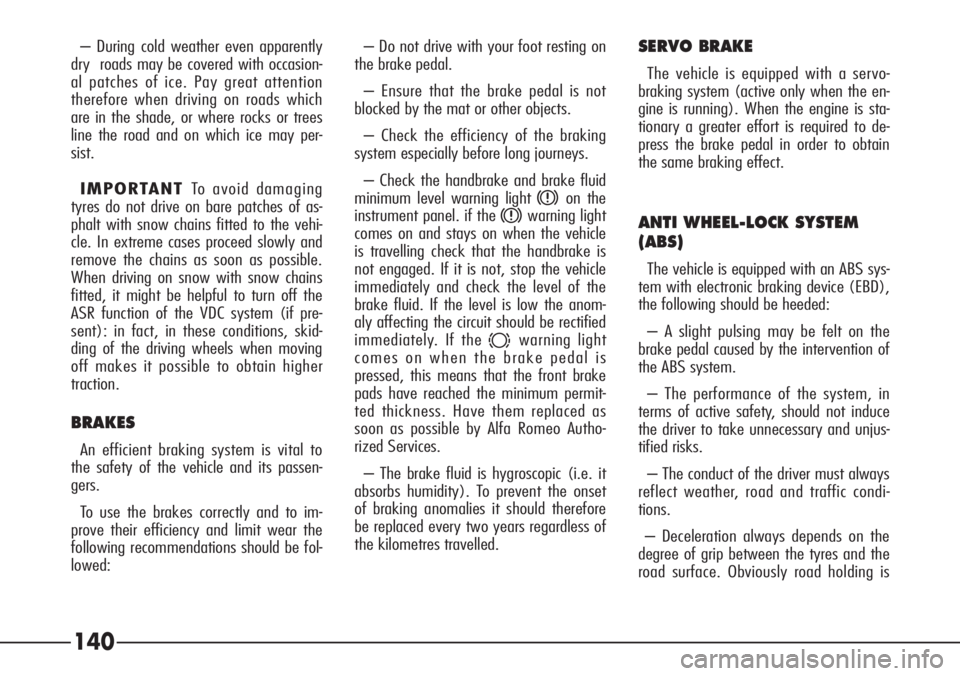
140
– During cold weather even apparently
dry roads may be covered with occasion-
al patches of ice. Pay great attention
therefore when driving on roads which
are in the shade, or where rocks or trees
line the road and on which ice may per-
sist.
IMPORTANT To avoid damaging
tyres do not drive on bare patches of as-
phalt with snow chains fitted to the vehi-
cle. In extreme cases proceed slowly and
remove the chains as soon as possible.
When driving on snow with snow chains
fitted, it might be helpful to turn off the
ASR function of the VDC system (if pre-
sent): in fact, in these conditions, skid-
ding of the driving wheels when moving
off makes it possible to obtain higher
traction.
BRAKES
An efficient braking system is vital to
the safety of the vehicle and its passen-
gers.
To use the brakes correctly and to im-
prove their efficiency and limit wear the
following recommendations should be fol-
lowed:– Do not drive with your foot resting on
the brake pedal.
– Ensure that the brake pedal is not
blocked by the mat or other objects.
– Check the efficiency of the braking
system especially before long journeys.
– Check the handbrake and brake fluid
minimum level warning light
xon the
instrument panel. if the
xwarning light
comes on and stays on when the vehicle
is travelling check that the handbrake is
not engaged. If it is not, stop the vehicle
immediately and check the level of the
brake fluid. If the level is low the anom-
aly affecting the circuit should be rectified
immediately. If the
dwarning light
comes on when the brake pedal is
pressed, this means that the front brake
pads have reached the minimum permit-
ted thickness. Have them replaced as
soon as possible by Alfa Romeo Autho-
rized Services.
– The brake fluid is hygroscopic (i.e. it
absorbs humidity). To prevent the onset
of braking anomalies it should therefore
be replaced every two years regardless of
the kilometres travelled.
SERVO BRAKE
The vehicle is equipped with a servo-
braking system (active only when the en-
gine is running). When the engine is sta-
tionary a greater effort is required to de-
press the brake pedal in order to obtain
the same braking effect.
ANTI WHEEL-LOCK SYSTEM
(ABS)
The vehicle is equipped with an ABS sys-
tem with electronic braking device (EBD),
the following should be heeded:
– A slight pulsing may be felt on the
brake pedal caused by the intervention of
the ABS system.
– The performance of the system, in
terms of active safety, should not induce
the driver to take unnecessary and unjus-
tified risks.
– The conduct of the driver must always
reflect weather, road and traffic condi-
tions.
– Deceleration always depends on the
degree of grip between the tyres and the
road surface. Obviously road holding is
Page 142 of 272
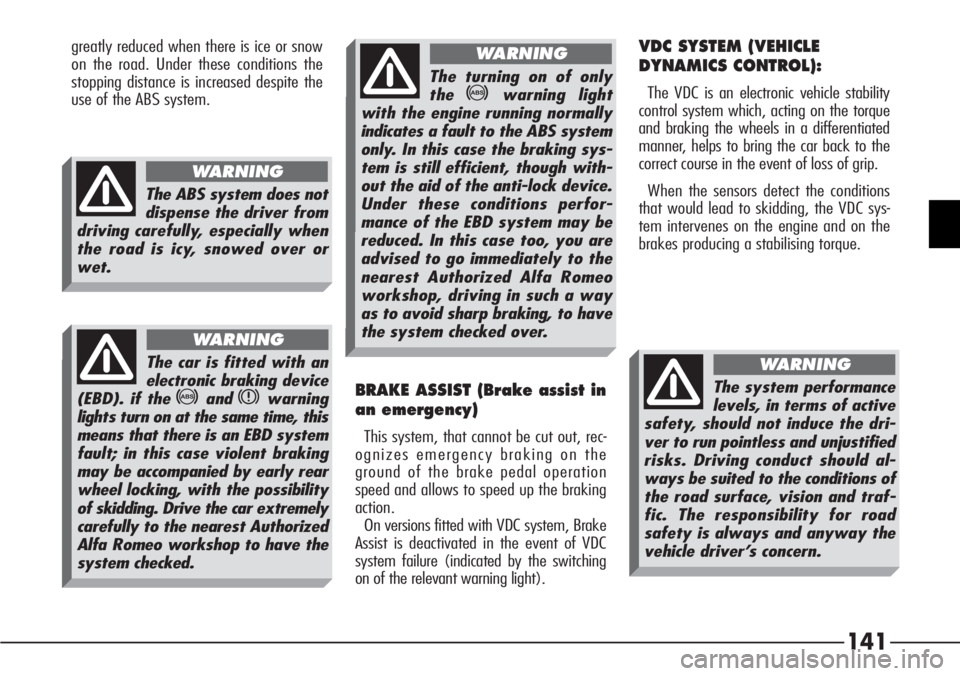
141
greatly reduced when there is ice or snow
on the road. Under these conditions the
stopping distance is increased despite the
use of the ABS system.VDC SYSTEM (VEHICLE
DYNAMICS CONTROL):
The VDC is an electronic vehicle stability
control system which, acting on the torque
and braking the wheels in a differentiated
manner, helps to bring the car back to the
correct course in the event of loss of grip.
When the sensors detect the conditions
that would lead to skidding, the VDC sys-
tem intervenes on the engine and on the
brakes producing a stabilising torque.
BRAKE ASSIST (Brake assist in
an emergency)
This system, that cannot be cut out, rec-
ognizes emergency braking on the
ground of the brake pedal operation
speed and allows to speed up the braking
action.
On versions fitted with VDC system, Brake
Assist is deactivated in the event of VDC
system failure (indicated by the switching
on of the relevant warning light).
The ABS system does not
dispense the driver from
driving carefully, especially when
the road is icy, snowed over or
wet.
WARNING
The car is fitted with an
electronic braking device
(EBD). if the
>andxwarning
lights turn on at the same time, this
means that there is an EBD system
fault; in this case violent braking
may be accompanied by early rear
wheel locking, with the possibility
of skidding. Drive the car extremely
carefully to the nearest Authorized
Alfa Romeo workshop to have the
system checked.
WARNING
The turning on of only
the
>warning light
with the engine running normally
indicates a fault to the ABS system
only. In this case the braking sys-
tem is still efficient, though with-
out the aid of the anti-lock device.
Under these conditions perfor-
mance of the EBD system may be
reduced. In this case too, you are
advised to go immediately to the
nearest Authorized Alfa Romeo
workshop, driving in such a way
as to avoid sharp braking, to have
the system checked over.
WARNING
The system performance
levels, in terms of active
safety, should not induce the dri-
ver to run pointless and unjustified
risks. Driving conduct should al-
ways be suited to the conditions of
the road surface, vision and traf-
fic. The responsibility for road
safety is always and anyway the
vehicle driver’s concern.
WARNING
Page 143 of 272
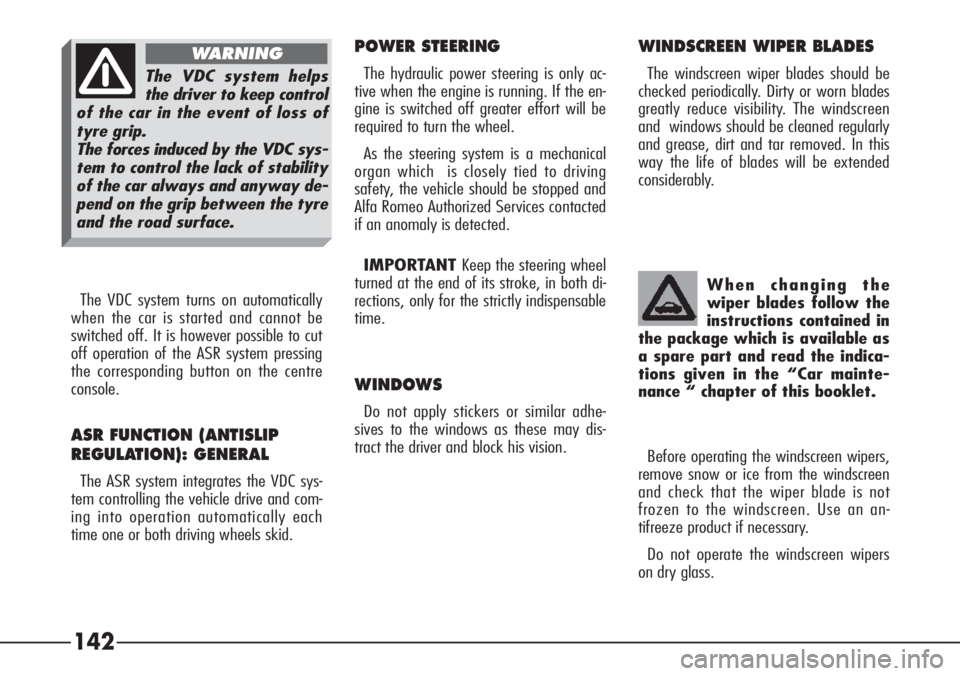
142
POWER STEERING
The hydraulic power steering is only ac-
tive when the engine is running. If the en-
gine is switched off greater effort will be
required to turn the wheel.
As the steering system is a mechanical
organ which is closely tied to driving
safety, the vehicle should be stopped and
Alfa Romeo Authorized Services contacted
if an anomaly is detected.
IMPORTANT Keep the steering wheel
turned at the end of its stroke, in both di-
rections, only for the strictly indispensable
time.
WINDOWS
Do not apply stickers or similar adhe-
sives to the windows as these may dis-
tract the driver and block his vision. The VDC system turns on automatically
when the car is started and cannot be
switched off. It is however possible to cut
off operation of the ASR system pressing
the corresponding button on the centre
console.
ASR FUNCTION (ANTISLIP
REGULATION): GENERAL
The ASR system integrates the VDC sys-
tem controlling the vehicle drive and com-
ing into operation automatically each
time one or both driving wheels skid.When changing the
wiper blades follow the
instructions contained in
the package which is available as
a spare part and read the indica-
tions given in the “Car mainte-
nance “ chapter of this booklet.
WINDSCREEN WIPER BLADES
The windscreen wiper blades should be
checked periodically. Dirty or worn blades
greatly reduce visibility. The windscreen
and windows should be cleaned regularly
and grease, dirt and tar removed. In this
way the life of blades will be extended
considerably.The VDC system helps
the driver to keep control
of the car in the event of loss of
tyre grip.
The forces induced by the VDC sys-
tem to control the lack of stability
of the car always and anyway de-
pend on the grip between the tyre
and the road surface.
WARNING
Before operating the windscreen wipers,
remove snow or ice from the windscreen
and check that the wiper blade is not
frozen to the windscreen. Use an an-
tifreeze product if necessary.
Do not operate the windscreen wipers
on dry glass.
Page 144 of 272
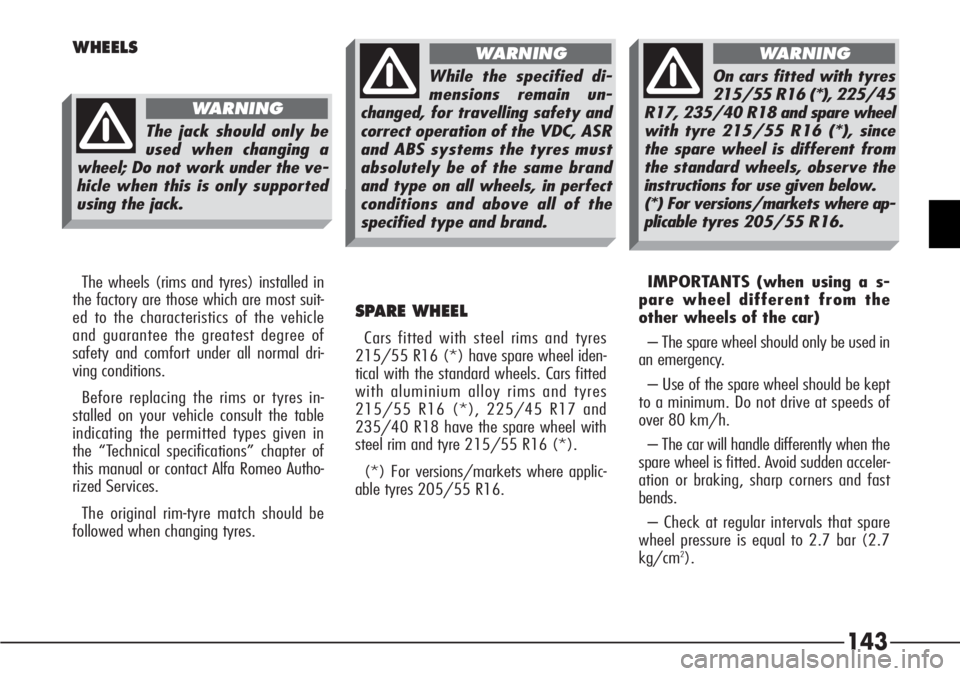
143
WHEELS
The wheels (rims and tyres) installed in
the factory are those which are most suit-
ed to the characteristics of the vehicle
and guarantee the greatest degree of
safety and comfort under all normal dri-
ving conditions.
Before replacing the rims or tyres in-
stalled on your vehicle consult the table
indicating the permitted types given in
the “Technical specifications” chapter of
this manual or contact Alfa Romeo Autho-
rized Services.
The original rim-tyre match should be
followed when changing tyres.IMPORTANTS (when using a s-
pare wheel different from the
other wheels of the car)
– The spare wheel should only be used in
an emergency.
– Use of the spare wheel should be kept
to a minimum. Do not drive at speeds of
over 80 km/h.
– The car will handle differently when the
spare wheel is fitted. Avoid sudden acceler-
ation or braking, sharp corners and fast
bends.
– Check at regular intervals that spare
wheel pressure is equal to 2.7 bar (2.7
kg/cm
2).
SPARE WHEEL
Cars fitted with steel rims and tyres
215/55 R16 (*) have spare wheel iden-
tical with the standard wheels. Cars fitted
with aluminium alloy rims and tyres
215/55 R16 (*), 225/45 R17 and
235/40 R18 have the spare wheel with
steel rim and tyre 215/55 R16 (*).
(*) For versions/markets where applic-
able tyres 205/55 R16.
The jack should only be
used when changing a
wheel; Do not work under the ve-
hicle when this is only supported
using the jack.
WARNING
While the specified di-
mensions remain un-
changed, for travelling safety and
correct operation of the VDC, ASR
and ABS systems the tyres must
absolutely be of the same brand
and type on all wheels, in perfect
conditions and above all of the
specified type and brand.
WARNING
On cars fitted with tyres
215/55 R16 (*), 225/45
R17, 235/40 R18 and spare wheel
with tyre 215/55 R16 (*), since
the spare wheel is different from
the standard wheels, observe the
instructions for use given below.
(*) For versions/markets where ap-
plicable tyres 205/55 R16.
WARNING
Page 145 of 272
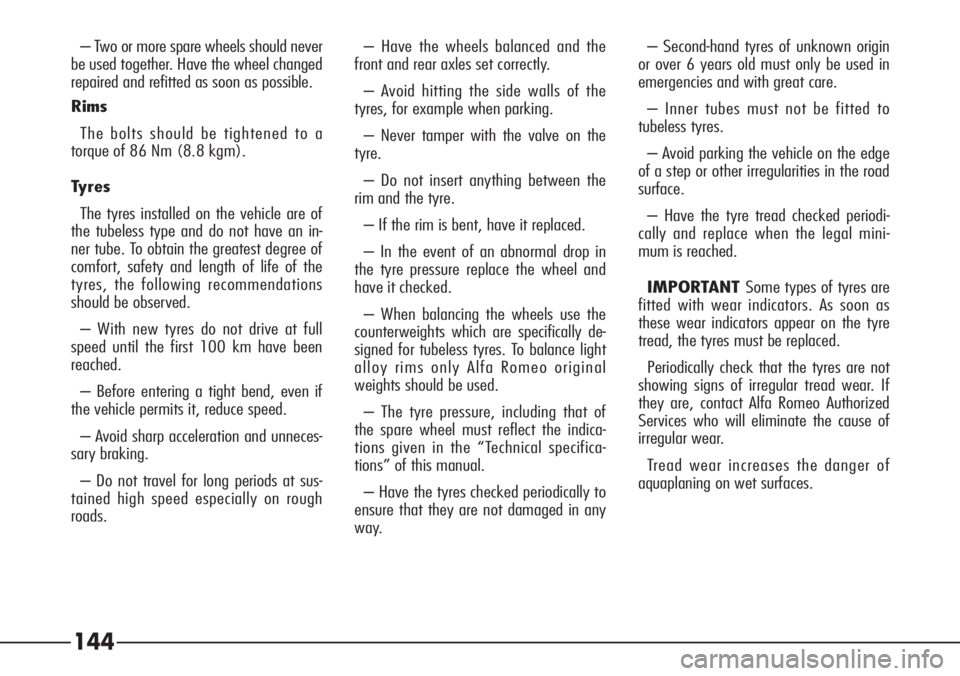
144
– Two or more spare wheels should never
be used together. Have the wheel changed
repaired and refitted as soon as possible.
Rims
The bolts should be tightened to a
torque of 86 Nm (8.8 kgm).
Tyres
The tyres installed on the vehicle are of
the tubeless type and do not have an in-
ner tube. To obtain the greatest degree of
comfort, safety and length of life of the
tyres, the following recommendations
should be observed.
– With new tyres do not drive at full
speed until the first 100 km have been
reached.
– Before entering a tight bend, even if
the vehicle permits it, reduce speed.
– Avoid sharp acceleration and unneces-
sary braking.
– Do not travel for long periods at sus-
tained high speed especially on rough
roads.– Have the wheels balanced and the
front and rear axles set correctly.
– Avoid hitting the side walls of the
tyres, for example when parking.
– Never tamper with the valve on the
tyre.
– Do not insert anything between the
rim and the tyre.
– If the rim is bent, have it replaced.
– In the event of an abnormal drop in
the tyre pressure replace the wheel and
have it checked.
– When balancing the wheels use the
counterweights which are specifically de-
signed for tubeless tyres. To balance light
alloy rims only Alfa Romeo original
weights should be used.
– The tyre pressure, including that of
the spare wheel must reflect the indica-
tions given in the “Technical specifica-
tions” of this manual.
– Have the tyres checked periodically to
ensure that they are not damaged in any
way.– Second-hand tyres of unknown origin
or over 6 years old must only be used in
emergencies and with great care.
– Inner tubes must not be fitted to
tubeless tyres.
– Avoid parking the vehicle on the edge
of a step or other irregularities in the road
surface.
– Have the tyre tread checked periodi-
cally and replace when the legal mini-
mum is reached.
IMPORTANT Some types of tyres are
fitted with wear indicators. As soon as
these wear indicators appear on the tyre
tread, the tyres must be replaced.
Periodically check that the tyres are not
showing signs of irregular tread wear. If
they are, contact Alfa Romeo Authorized
Services who will eliminate the cause of
irregular wear.
Tread wear increases the danger of
aquaplaning on wet surfaces.
Page 146 of 272

145
To ensure uniform wear between the
tyres on the front axle and those on the
rear axle, the tyres should be switched
around every 10,000 - 15,000 km keep-
ing the tyres on the same side of the ve-
hicle to avoid inverting the direction of ro-
tation (fig. 1).Note for one way tyres: There
are arrows on the side of one-way tyres
indicating the direction of rotation. When
a wheel is changed (for example after a
puncture, the direction of the arrow on
the spare wheel might not coincide with
the direction of rotation of the wheel to
be changed. Even in these conditions the
tyre is still safe but you are advised to
have the tyre repaired and refitted as
soon as possible, because top perfor-
mance is obtained when all the wheels
turn in the direction of the arrow.Tyre pressure and wear
The correct tyre pressure will not only
ensure that your tyres last longer but will
also make your vehicle safer as they have
a direct influence over road holding.
The pressure of each tyre, including that
of the spare tyre should be checked regu-
larly and always before a long journey.
The tyres should be checked when cold
using a pressure gauge and inflated to
the pressure given in the chapter “Techni-
cal specifications”.
Incorrect tyre pressure causes tyre wear
(fig. 2):
Do not cross the tyres
over.
WARNING
3212CAm
fig. 2
A0D0037m
fig. 1
Page 147 of 272
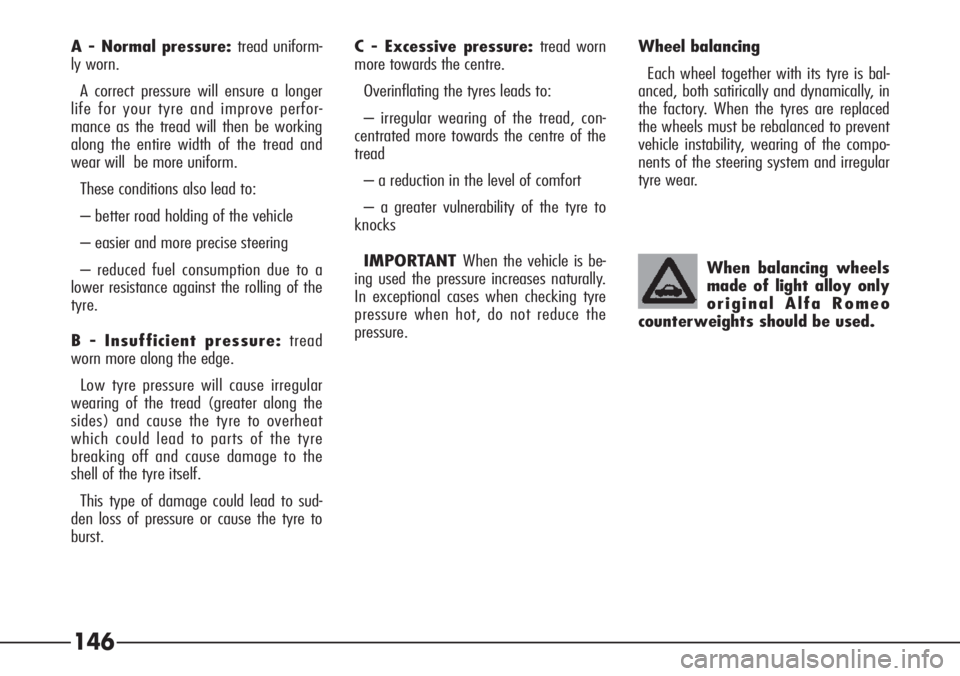
146
A - Normal pressure: tread uniform-
ly worn.
A correct pressure will ensure a longer
life for your tyre and improve perfor-
mance as the tread will then be working
along the entire width of the tread and
wear will be more uniform.
These conditions also lead to:
– better road holding of the vehicle
– easier and more precise steering
– reduced fuel consumption due to a
lower resistance against the rolling of the
tyre.
B - Insufficient pressure: tread
worn more along the edge.
Low tyre pressure will cause irregular
wearing of the tread (greater along the
sides) and cause the tyre to overheat
which could lead to parts of the tyre
breaking off and cause damage to the
shell of the tyre itself.
This type of damage could lead to sud-
den loss of pressure or cause the tyre to
burst.C - Excessive pressure: tread worn
more towards the centre.
Overinflating the tyres leads to:
– irregular wearing of the tread, con-
centrated more towards the centre of the
tread
– a reduction in the level of comfort
– a greater vulnerability of the tyre to
knocks
IMPORTANT When the vehicle is be-
ing used the pressure increases naturally.
In exceptional cases when checking tyre
pressure when hot, do not reduce the
pressure.Wheel balancing
Each wheel together with its tyre is bal-
anced, both satirically and dynamically, in
the factory. When the tyres are replaced
the wheels must be rebalanced to prevent
vehicle instability, wearing of the compo-
nents of the steering system and irregular
tyre wear.
When balancing wheels
made of light alloy only
original Alfa Romeo
counterweights should be used.
Page 148 of 272
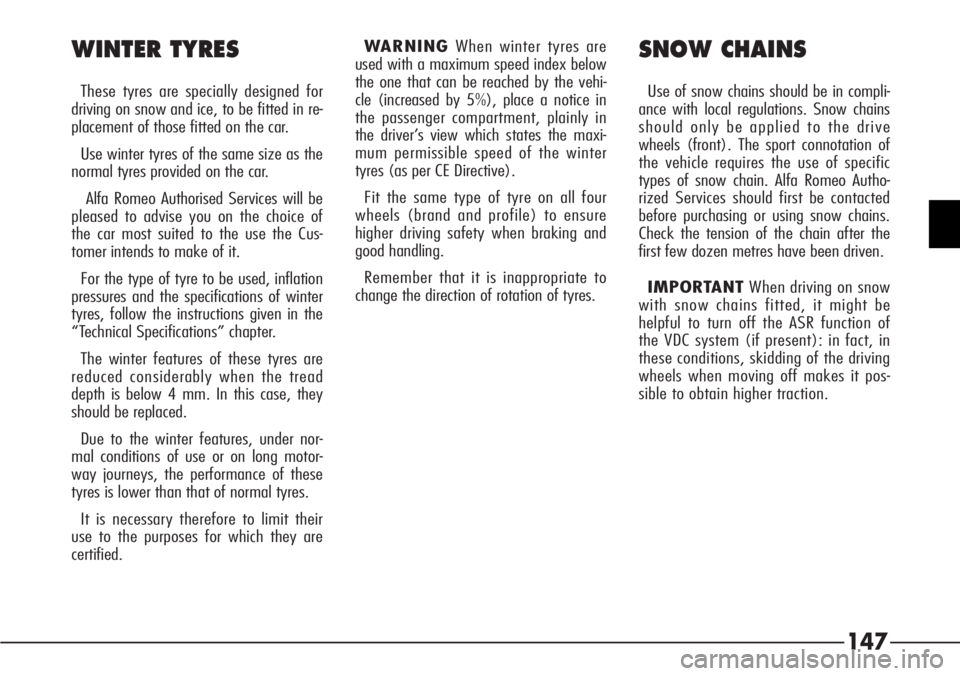
147
WINTER TYRES
These tyres are specially designed for
driving on snow and ice, to be fitted in re-
placement of those fitted on the car.
Use winter tyres of the same size as the
normal tyres provided on the car.
Alfa Romeo Authorised Services will be
pleased to advise you on the choice of
the car most suited to the use the Cus-
tomer intends to make of it.
For the type of tyre to be used, inflation
pressures and the specifications of winter
tyres, follow the instructions given in the
“Technical Specifications” chapter.
The winter features of these tyres are
reduced considerably when the tread
depth is below 4 mm. In this case, they
should be replaced.
Due to the winter features, under nor-
mal conditions of use or on long motor-
way journeys, the performance of these
tyres is lower than that of normal tyres.
It is necessary therefore to limit their
use to the purposes for which they are
certified.WARNINGWhen winter tyres are
used with a maximum speed index below
the one that can be reached by the vehi-
cle (increased by 5%), place a notice in
the passenger compartment, plainly in
the driver’s view which states the maxi-
mum permissible speed of the winter
tyres (as per CE Directive).
Fit the same type of tyre on all four
wheels (brand and profile) to ensure
higher driving safety when braking and
good handling.
Remember that it is inappropriate to
change the direction of rotation of tyres.
SNOW CHAINS
Use of snow chains should be in compli-
ance with local regulations. Snow chains
should only be applied to the drive
wheels (front). The sport connotation of
the vehicle requires the use of specific
types of snow chain. Alfa Romeo Autho-
rized Services should first be contacted
before purchasing or using snow chains.
Check the tension of the chain after the
first few dozen metres have been driven.
IMPORTANTWhen driving on snow
with snow chains fitted, it might be
helpful to turn off the ASR function of
the VDC system (if present): in fact, in
these conditions, skidding of the driving
wheels when moving off makes it pos-
sible to obtain higher traction.
Page 149 of 272
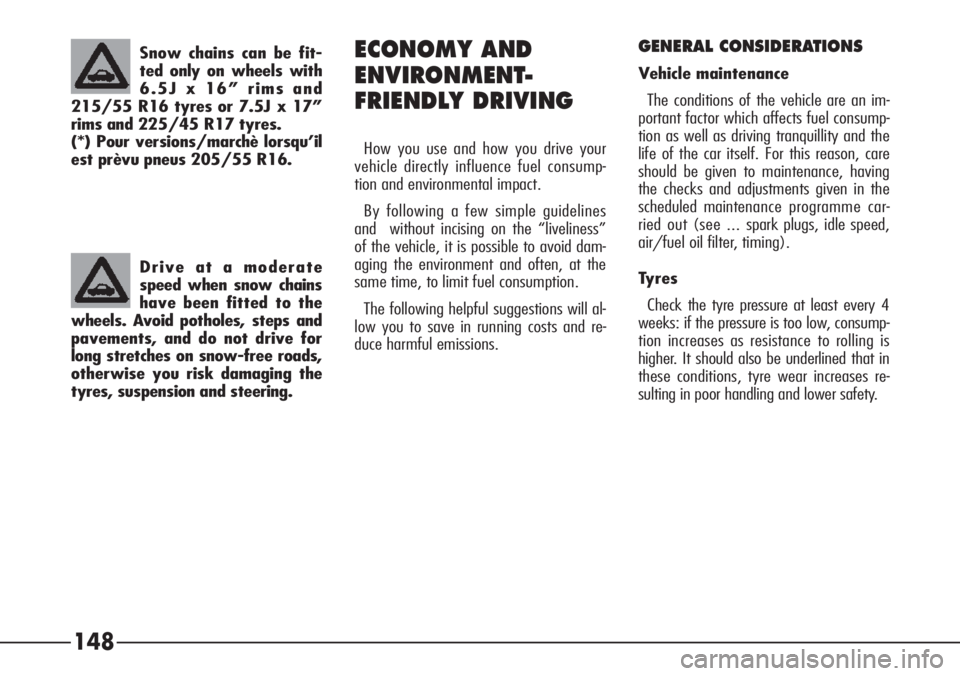
148ECONOMY AND
ENVIRONMENT-
FRIENDLY DRIVING
How you use and how you drive your
vehicle directly influence fuel consump-
tion and environmental impact.
By following a few simple guidelines
and without incising on the “liveliness”
of the vehicle, it is possible to avoid dam-
aging the environment and often, at the
same time, to limit fuel consumption.
The following helpful suggestions will al-
low you to save in running costs and re-
duce harmful emissions.
GENERAL CONSIDERATIONS
Vehicle maintenance
The conditions of the vehicle are an im-
portant factor which affects fuel consump-
tion as well as driving tranquillity and the
life of the car itself. For this reason, care
should be given to maintenance, having
the checks and adjustments given in the
scheduled maintenance programme car-
ried out (see ... spark plugs, idle speed,
air/fuel oil filter, timing).
Tyres
Check the tyre pressure at least every 4
weeks: if the pressure is too low, consump-
tion increases as resistance to rolling is
higher. It should also be underlined that in
these conditions, tyre wear increases re-
sulting in poor handling and lower safety. Drive at a moderate
speed when snow chains
have been fitted to the
wheels. Avoid potholes, steps and
pavements, and do not drive for
long stretches on snow-free roads,
otherwise you risk damaging the
tyres, suspension and steering.
Snow chains can be fit-
ted only on wheels with
6.5J x 16” rims and
215/55 R16 tyres or 7.5J x 17”
rims and 225/45 R17 tyres.
(*) Pour versions/marchè lorsqu’il
est prèvu pneus 205/55 R16.
Page 150 of 272
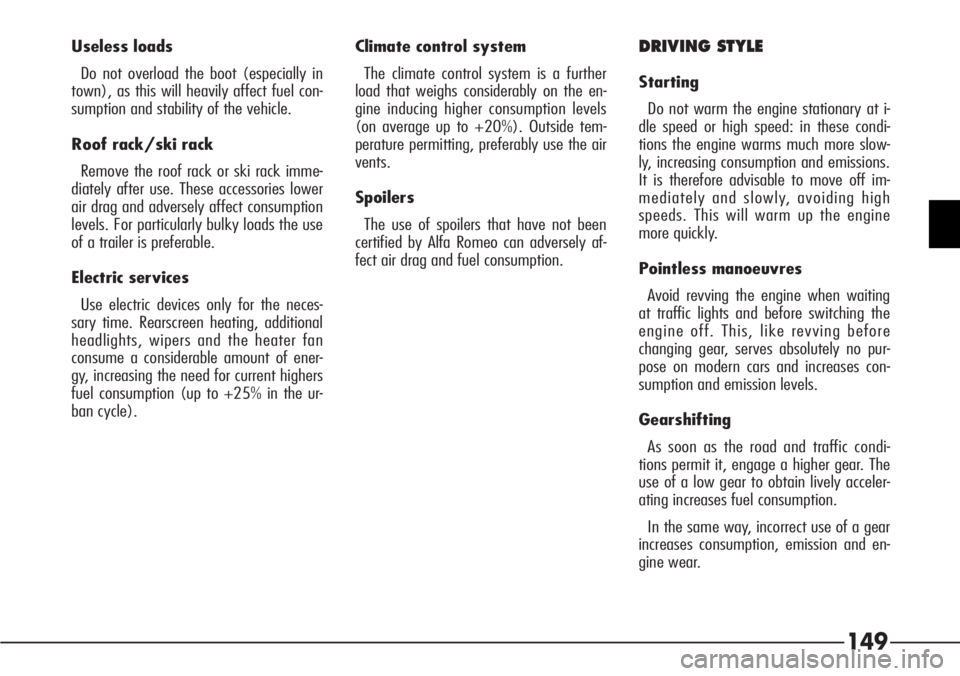
149
Useless loads
Do not overload the boot (especially in
town), as this will heavily affect fuel con-
sumption and stability of the vehicle.
Roof rack/ski rack
Remove the roof rack or ski rack imme-
diately after use. These accessories lower
air drag and adversely affect consumption
levels. For particularly bulky loads the use
of a trailer is preferable.
Electric services
Use electric devices only for the neces-
sary time. Rearscreen heating, additional
headlights, wipers and the heater fan
consume a considerable amount of ener-
gy, increasing the need for current highers
fuel consumption (up to +25% in the ur-
ban cycle).Climate control system
The climate control system is a further
load that weighs considerably on the en-
gine inducing higher consumption levels
(on average up to +20%). Outside tem-
perature permitting, preferably use the air
vents.
Spoilers
The use of spoilers that have not been
certified by Alfa Romeo can adversely af-
fect air drag and fuel consumption.DRIVING STYLE
Starting
Do not warm the engine stationary at i-
dle speed or high speed: in these condi-
tions the engine warms much more slow-
ly, increasing consumption and emissions.
It is therefore advisable to move off im-
mediately and slowly, avoiding high
speeds. This will warm up the engine
more quickly.
Pointless manoeuvres
Avoid revving the engine when waiting
at traffic lights and before switching the
engine off. This, like revving before
changing gear, serves absolutely no pur-
pose on modern cars and increases con-
sumption and emission levels.
Gearshifting
As soon as the road and traffic condi-
tions permit it, engage a higher gear. The
use of a low gear to obtain lively acceler-
ating increases fuel consumption.
In the same way, incorrect use of a gear
increases consumption, emission and en-
gine wear.